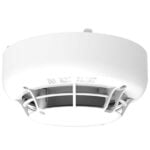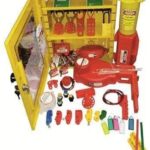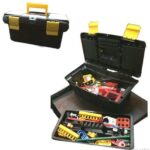Your list is empty, add products to the list to send a request
How Do Fire Alarm Panels Work?

25
Jul
A fire alarm system is only as good as its control panel. If you’ve ever wondered how do fire alarm panels work, you’re not alone. Understanding how these panels operate is essential for building managers, safety officers, business owners, and even homeowners who want to protect their space.
In this guide, you’ll get a full breakdown of how fire panels function, the different types available, and why they are so important for fire detection and emergency response.
What Is a Fire Alarm Panel?
A fire alarm panel—also called a fire alarm control panel (FACP)—is the central brain of a fire alarm system. It monitors all the devices connected to the system, including smoke detectors, manual call points, heat sensors, and sirens.
When one of these devices detects a possible fire, the panel receives a signal, processes it, and activates alarms. It may also notify emergency services, trigger sprinklers, or unlock doors for evacuation, depending on how it’s configured.
How Do Fire Alarm Panels Work?
The function of a fire alarm panel can be broken down into several stages:
1. Constant Monitoring
The panel continually monitors all input devices—detectors, call points, and other sensors—for changes. It checks for smoke, heat, gas, or manual activation.
2. Signal Processing
When a sensor is triggered, the device sends an electric signal to the control panel. The panel verifies this input, checking for errors or false alarms.
3. Activation of Alarms
If the panel confirms a real fire threat, it activates output devices. These include:
- Audible alarms (sirens, buzzers)
- Visual alarms (flashing strobes)
- Sprinkler systems
- Emergency lighting
- Door release mechanisms
4. Display of Zone or Device Location
Most panels divide the property into zones or use addressable technology. This helps responders identify exactly where the fire or issue is.
5. Data Logging
Modern panels log all activity—alarms, faults, resets—along with time stamps. This is important for audits, fire investigations, and maintenance tracking.
Types of Fire Alarm Panels
There are two main types of fire alarm panels:
Conventional Fire Panels
- Divide buildings into physical zones
- Lower cost, but don’t show the exact device location
- Suitable for smaller premises
- Example: A basic panel that displays “Zone 4 – Alarm”
Addressable Fire Panels
- Each device has a unique ID or address
- Can display exact room or area of activation
- Better for large, complex buildings
- Offer advanced diagnostics, event logging, and more
For example, the Avani Addressable Fire Alarm Control Panel provides zone-specific alerts and supports multiple inputs and outputs for detailed control and quick action.
Components of a Fire Alarm Panel System
Knowing the parts inside the panel can help you better understand how it works:
- Display Panel: Shows system status, alarms, faults, and zones
- Control Keys: Includes reset, silence, test, and override buttons
- Circuit Boards: Connect and power the input/output devices
- Battery Backup: Ensures the system runs during power failures
- Zone LEDs or LCD Display: Highlights active zones or devices
- Event Log (in advanced systems): Records faults, tests, and fire events
How Fire Panels Handle Different Events
| Condition | Panel Action |
| Fire Detected | Sounds alarms, displays zone, activates emergency systems |
| System Fault | Triggers a yellow LED or trouble alert |
| Loss of Power | Switches to battery, issues a fault alert |
| Manual Reset | Waits for user input to reset after alarm event |
| Test Mode | Allows safe testing of alarms without emergency activation |
Key Features of Addressable Panels Like Avani
- LCD screen for detailed status
- Device-by-device fault detection
- Programmable logic (e.g., sounders activate after delay)
- Loop-based wiring for flexibility
- Event memory and data history
- Integration with BMS (Building Management Systems)
Fire Alarm Panel Security and Access
Most fire alarm control panels have multiple user levels:
- User Level 1: Basic actions like silence or reset
- User Level 2: Maintenance actions like testing
- Installer Level: Configuration, programming, and device setup
Access is typically restricted by key switches, passwords, or secure logins.
Routine Maintenance and Checks
To ensure the panel works correctly, you should:
Daily:
- Check the panel display shows “System Normal”
- Ensure power LED is green
- Look for any fault lights
Weekly:
- Test a manual call point or smoke detector
- Confirm alarm triggers and resets
Monthly:
- Inspect battery voltage and wiring
- Run a backup power test
Annually:
- Have a certified technician conduct a full system check
Frequently Asked Questions
1. What is a fire alarm panel?
A fire alarm panel is the central control unit of a fire detection system. It receives signals from sensors, verifies threats, activates alarms, and helps emergency teams identify where the problem is. It’s essential for coordinated fire response and safety.
2. How do alarm panels work?
Alarm panels work by constantly monitoring input devices like smoke detectors. When an alarm signal is received, the panel processes it and triggers alerts. It also logs the event and can send signals to activate other systems like sprinklers or emergency exits.
3. Why are fire panels important?
Fire panels are critical because they provide immediate notification of fire threats. They help contain damage, guide evacuation, and alert emergency responders. Without them, identifying a fire and reacting in time would be delayed, putting lives and property at risk.
Recommended Product: Avani Addressable Fire Alarm Panel
Looking for a reliable, feature-rich panel?
Avani Addressable Fire Alarm Control Panel (RAVEL)
- Zone-based addressable technology
- LCD interface for clarity
- Battery backup for power failure protection
- Scalable for large or small buildings
Final Thoughts
Understanding how fire alarm panels work is essential for anyone responsible for building safety. From constant monitoring to emergency activation and clear zone identification, fire panels are the silent guardians behind every safe evacuation.
Whether you’re setting up a new system or maintaining an existing one, choose a panel that’s easy to use, built to last, and designed for accuracy—like the Avani Addressable Panel.
Be prepared before disaster strikes.
Order your Ravel Avani panel from Fire Supplies and ensure your fire alarm system is built on intelligence, speed, and reliability.



























